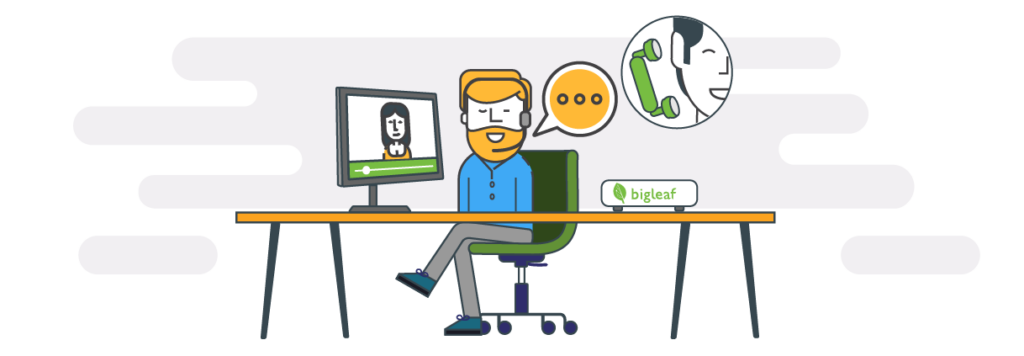How to transform communications with Bigleaf
Work-from-home and social distancing trends accelerated during the COVID-19 pandemic, as organizations found new ways to connect with their customers, partners, and vendors in the new environment.
Many of their plans revolved around new or increased reliance on VoIP and UCaaS, with solutions including Zoom, Microsoft Teams, and GoToMeeting. Common issues arose with the internet-reliant systems, including calls that sound choppy or robotic, or drop altogether, as well as outages or lag that affect the performance of VoIP phone calls, video conferences, and screen shares in collaboration apps.

Bigleaf worked with a number of business and non-profit organizations to address performance problems they faced with VoIP and UCaaS solutions.
Worry-free video conferencing for church services
During the pandemic, churches and places of worship were not always able to host in-person services. Some turned to video conferencing technology, like Zoom. Even after the pandemic, Zoom services have continued as a convenience for homebound congregants. During the Zoom call, it was critical to have a reliable internet connection so the service would not be interrupted, and there would be no time to deal with any technical issues during the service itself. Plus, most churches did not have on-site technical support staff to handle any problems in real time.
Bigleaf was able to provide a straightforward solution for churches and other organizations. They were able to install and maintain the Bigleaf solution without technical expertise. Bigleaf’s owned and operated Cloud Access Network is fully redundant and peers directly with apps like Zoom, so the churches can have faith in their internet connections and offer uninterrupted services for their congregants to enjoy remotely or in person.
Reliable voice and video calls for medical offices
Many medical offices and other healthcare providers redesigned their patient interactions due to the pandemic. Telehealth visits became a vital part of patient care, adding new requirements to strained phone and video call capabilities. The phone systems were also critical to management of patient appointments, prescriptions, and general consultation, and in some cases, phones were used on-site for curbside check-ins.
One healthcare provider contacted Bigleaf to help upgrade their system to accommodate new services and capabilities. They were running an old T-1 PRI line, which kept going down as often as 3x per day over a 15-month period. On one memorable occasion, the line was down for 3 entire days.
All of this downtime resulted in lost appointments and much frustration. It jeopardized the clinic’s potential to provide critical care. The old system couldn’t support a normal workload, and it was totally inadequate as a basis for the new patient communication model that was required to serve patients during the pandemic.
The medical office switched over to a fiber line and added Bigleaf to support the performance-sensitive, cloud-based VoIP and UCaaS cloud applications. Bigleaf provided the stability needed for the new voice- and video-dependent systems and processes.
The clinic did not have on-site tech staff so they needed assurance that their systems would work autonomously. They were also planning to switch from a server-based electronic medical record (EMR) system to a cloud-based application. Worry-free internet was a requirement for that transition, too.
Bigleaf provided the performance they needed during the early days of the pandemic, with room to grow their digital infrastructure to accommodate future needs.
Protecting quality of service for business-critical applications
Even after the pandemic, many organizations continue to rely on video conferencing technology and voice calls to interact with remote colleagues and customers.
One technology development company built out new office space with several “Zoom Rooms,” to help teams interact with remote coworkers or maintain physical distance in the office environment. Video calls and conferences are critical to the company’s operations.
Meanwhile, some of the company’s employees stream YouTube videos and other bandwidth-intensive apps while they work. These apps can hog network resources and disrupt VoIP and other sessions.
VoIP and UCaaS traffic is very sensitive to internet performance, and the company needed to ensure that they would continue uninterrupted. Bigleaf’s Dynamic QoS and Cloud Access Network work together to prioritize the business-critical applications automatically.
Bigleaf detects and responds to change in the available circuit throughput, when sensitive traffic can be affected, and prioritizing both inbound and outbound VoIP and UCaaS traffic ahead of the bulk data transfers such as YouTube traffic. Bigleaf Dynamic QoS detects the bandwidth bottleneck in the paths to and from the customer’s site and adapts QoS to ensure traffic isn’t buffered in QoS-unaware ISP routers.
Better VoIP and UCaaS with Bigleaf
For those and other organizations, reliable VoIP and video calls continue to be critical to their success. To accomplish their goals, they depend on the internet. And their internet connectivity depends on Bigleaf.
To learn more about Bigleaf’s role in VoIP and UCaaS system performance, watch this on-demand webinar, Fix Bad Video and VoIP Calls for Good. Or contact us for a free, 30-minute demo.







